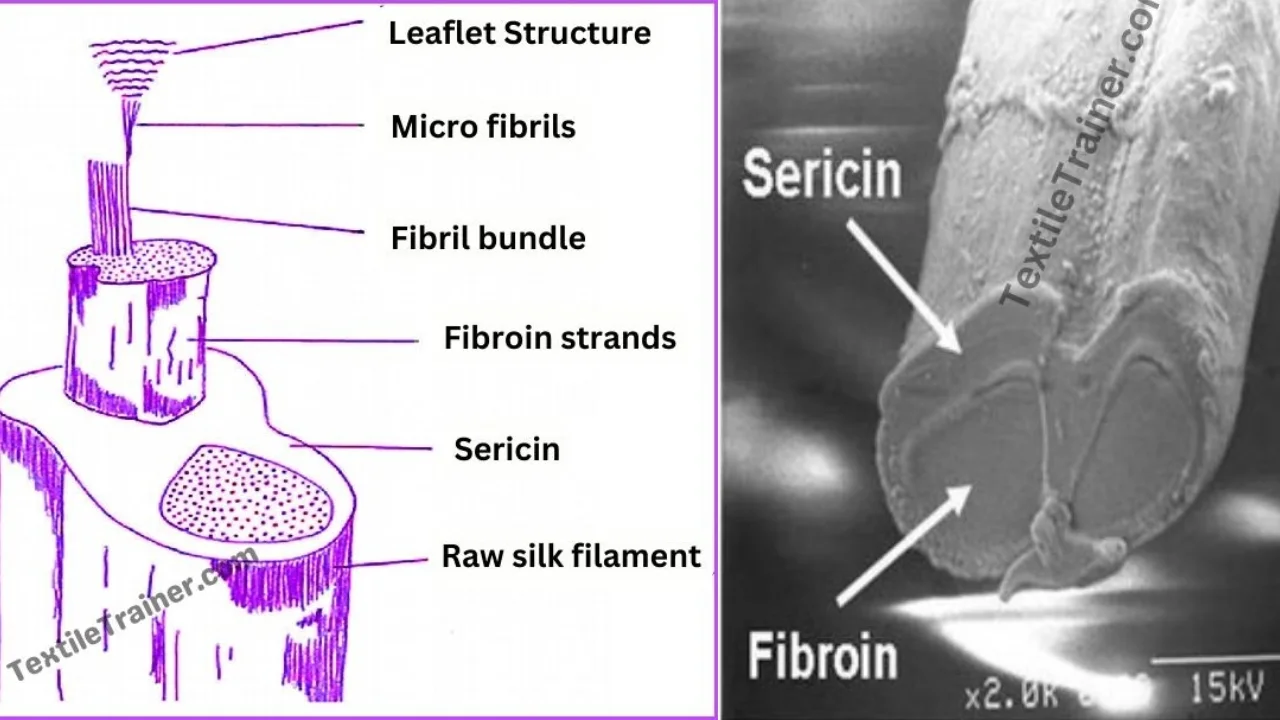Best 14 Thermal Properties and 9 Chemical Properties of wool
Introduction
Thermal properties of wool fiber and chemical properties of wool fiber will be describe in this article. In the previous article, we described physical properties of wool. But here we will describe thermal properties of wool and chemical properties of wool. Before going to the discussion of properties of wool, we will learn something about wool fiber. Wool was one of the earliest fibers to be spun into yarns and woven into cloth.
The wool fiber was one of the most widely used textile fibers before the Industrial Revolution. Sheep may have been one of the first domesticated animals. Originally, the fleece of a primitive sheep consists of a thick, hairy outercoat and a light, downy undercoat. A modern domesticated sheep’s fleece is mostly composed of the soft undercoat. Merino sheep, which do not contain any Kemp fiber, was developed by the Spanish. All other sheep breeds still contain a small amount of kemp in their fleeces.

Thermal Properties of Wool Fiber:
A dry wool fiber will burn slowly with a sputtering, smoky flame and will self-extinguish when removed from the flame. Wool fibers scorch at 204°C and will eventually turn to char at 300°C. As wool is heated, it degrades and yellows at 150°C and chars at 300°C. The fibers will form charred black knobs when they are removed from the flame. A burn smell will be similar to burning feathers. The fibers will be removed from the flame and have become charred. However, below are listed some common thermal properties of wool.
1. Thermal Regulation and Clothing Comfort:
Whenever wool absorbs moisture, it produces heat, so wearing a wool jersey in a cold, damp environment keeps you warm by picking up water vapor. In the warm room, moisture passes into the atmosphere, cooling you down. Wool fibres have tiny pores called skin-cores. In this structure, the inner cortex is hydrophilic in nature due to the large number of polar groups contained in the polypeptide chains of the cortex. As a result, wool fibers have hydrophobic outer surfaces due to a high degree of disulphide cross-water vapor passing through them.
Wool linkages form in the cuticle and fatty acids form a film covering the fiber surface that prevents diffusion. In both warm and cool conditions, cuticle cells provide comfort. Warm weather garments such as sweaters and suits are ideal for wool. It holds up to 30-35% of its own weight in water vapor, allowing it to regulate the microclimate surrounding the body. As a result, it remains dry and cools the body. In cold weather, it can provide warmth, while in hot weather, it releases heat and moisture to keep you cool.
2. Odor reducing:
In spite of the fact that sweat itself has no odor, if it remains on the skin for a long period of time, bacteria will develop and create unpleasant odors. Wool absorbs sweat and evaporates it quickly.
3. Anti-bacterial:
In contrast, microorganisms are attracted to smooth, positively charged surfaces. The scaly surfaces of wool fibers do not attract microorganisms.
4. Anti-static:
An excellent anti-static property of wool is its ability to absorb a large amount of moisture.
5. Natural stretch:
Merino fibers stretch with the wearer, but then return to their natural shape, so garments won’t sag or lose their shape as much. Merino is a renewable resource, and garments are often cherished for decades, but they eventually degrade and return to their natural state.
6. Insulation:
Due to the crimp in wool fibers, they stand apart from each other and trap insulating air between them, making it comfortable in hot and cold weather. The wool fibers absorb moisture vapor, making them comfortable regardless of the weather. In hot weather, absorption/evaporation works to help keep the body cool. Still air is one of nature’s best insulators.
7. Fire resistant:
A fabric made entirely of wool is difficult to ignite, burns slowly, and can only sustain a flame for a short time. Wool does not melt when burned, so it is not able to stick to the skin and cause serious injury.
8. Durable:
Each wool fiber is a coiled spring that stretches and gives rather than breaking. Its interlocking protein molecules enable wool fibers to elongate, stretch, and recover, creating an extremely durable fabric.
9. Static resistant:
A wool garment will not attract static electricity since it absorbs moisture naturally. Wool garments have a much lower tendency to ‘spark’ or cling.
10. Noise insulation:
It is a fact that wool absorbs noise and reduces the level of noise.
11. Dirt resistant:
The crimps in the fibers and the scales on the outside of the fiber resist deep dirt from penetrating the fabric, as wool absorbs moisture and, therefore, doesn’t build up static electricity.
12. Versatile:
There are many different sheep breeds with unique fiber characteristics that provide different types of wool for a wide variety of uses.
13. Dye-ability:
A wool fiber can dye easily. The scales on the surface give softer colors and reduce reflection. The protein in the core of the fiber absorbs and combines with many dyes, allowing the fiber to retain its color.
14. Comfort:
As a result of its elasticity, and the fact that it absorbs moisture, wool is an extremely comfortable material to wear.
Chemical properties of wool:
1. Effect of alkalis:
Even weak bases at low dilutions can easily destroy wool. Alkaline solutions can open the disulphide crosslinks of wool, while hot alkalis may dissolve it. In boiling water with sodium hydroxide, wool dissolves completely. Caustic soda will completely destroy it as well. When used hot, or for an extended period of time, weak sodium carbonate solutions can damage wool.
2. Effect of acids:
Acids are more resistant to wool because they hydrolyze peptide groups but leave disulfide bonds intact, which crosslink the polymers. Even though this weakens the polymer system, it doesn’t dissolve the fiber. The only acids that damage wool are hot sulphuric acid and nitric acid. A concentration of mineral acids will destroy wool if it is soaked for more than a few minutes in concentrated mineral acids. Acids are used to activate salt links in wool fibers, so dye can be applied.
3. Effect of bleach:
Wool can be damaged by bleaches that contain chlorine compounds. Products with hypochlorite will cause it to become yellow and dissolve at room temperature. By destroying the scales, various forms of chlorine are used to create ‘unshrinkable wool’. This wool is weaker, less elastic and has no felting properties. Using dilute oxidizing bleaches such as hypochlorite can permanently damage and dye wool. Wool can be cleaned with bleaches containing hydrogen peroxide, sodium perborate, sodium peroxide, and potassium permanganate without harming it.
4. Reduction:
Wool can be partially reduced by the use of reducing agents under controlled conditions.
5. Effect of sunlight:
The UV rays of sunlight cause the disulfide bonds of cystine to break, which in turn leads to photochemical oxidation, which leads to fiber degradation and eventual destruction. Wool is attacked by short wavelength ultraviolet light, which causes slow degradation and yellowing. Wet fabrics are more severely faded and weakened than dry fabrics.
6. Effect of perspiration:
Since wool is easily deteriorated by alkalis, perspiration, which is alkaline, will weaken wool by hydrolyzing peptide bonds and amide side chains. Perspiration in general will result in discoloration.
7. Effect of water:
Moisture is absorbed by wool (hygroscopic). It can absorb about 30% of its mass of water vapor without feeling wet. It releases moisture slowly. Despite its strong affinity for water, fibers have a highly water repellent (hydrophobic) surface because they are covered by extremely thin skin. A long boiling process will dissolve and decompose small amounts of fiber, causing liquid water to roll into droplets. Boiling water reduces luster and promotes felting. The heat makes the fiber more elastic and plastic, making it easier to move and entangle itself with other fibers.
8. Biological properties of wool:
Moths able to dissolve and digest wool fibers can attack wool. As a result of the chemical structure of the cystine cross-linkages in wool, it is particularly susceptible to moth larvae and carpet beetle larvae. Despite the fact that wool is quite resistant to attack by other biological agents such as mildew, raw wool can contain inactive spores that become active when wet. If wool is left damp for a long time, it will develop mildew.
9. Cleaning and Ironing:
It is recommended to dry clean wool items, since solvents do not harm wool and cause less wrinkles, fuzz, and shrinkage. The tumbling of damp wool fabrics may cause excessive felting shrinkage, so it is not a good idea to tumble dry them. Due to the negative effect that heat has on wool fibers, ironing temperatures should be kept low, and press cloths should be used. Steaming will partially shrink and condition the fabric, so caution should be taken.
These are the chemical and thermal properties of wool fiber.
You May Read:
- History of wool with geographical distribution.
- Classification of wool fiber.
- Morphology of wool fiber.
- Woolen Vs Worsted Fabric.
- Wool Manufacturing Process.
- Physical Properties of wool.
Reference:
- Cook, J. G. (2005). Handbook of Textile Fibers. Delhi: WoodHead Publishing Limited.
- Corbman, B. P. (1987). Textile Fiber to Fabric. Singapore: McGraw Hill Book Co.
- Dr. Hosne Ara Begum, P. D. (n.d.). Natural fibers. Dhaka: Hafiz book center.
- Nakamura, A. (2005). Fiber Science and Technology. Delhi: Allied Books and Publishing Co. Pvt. Ltd.



